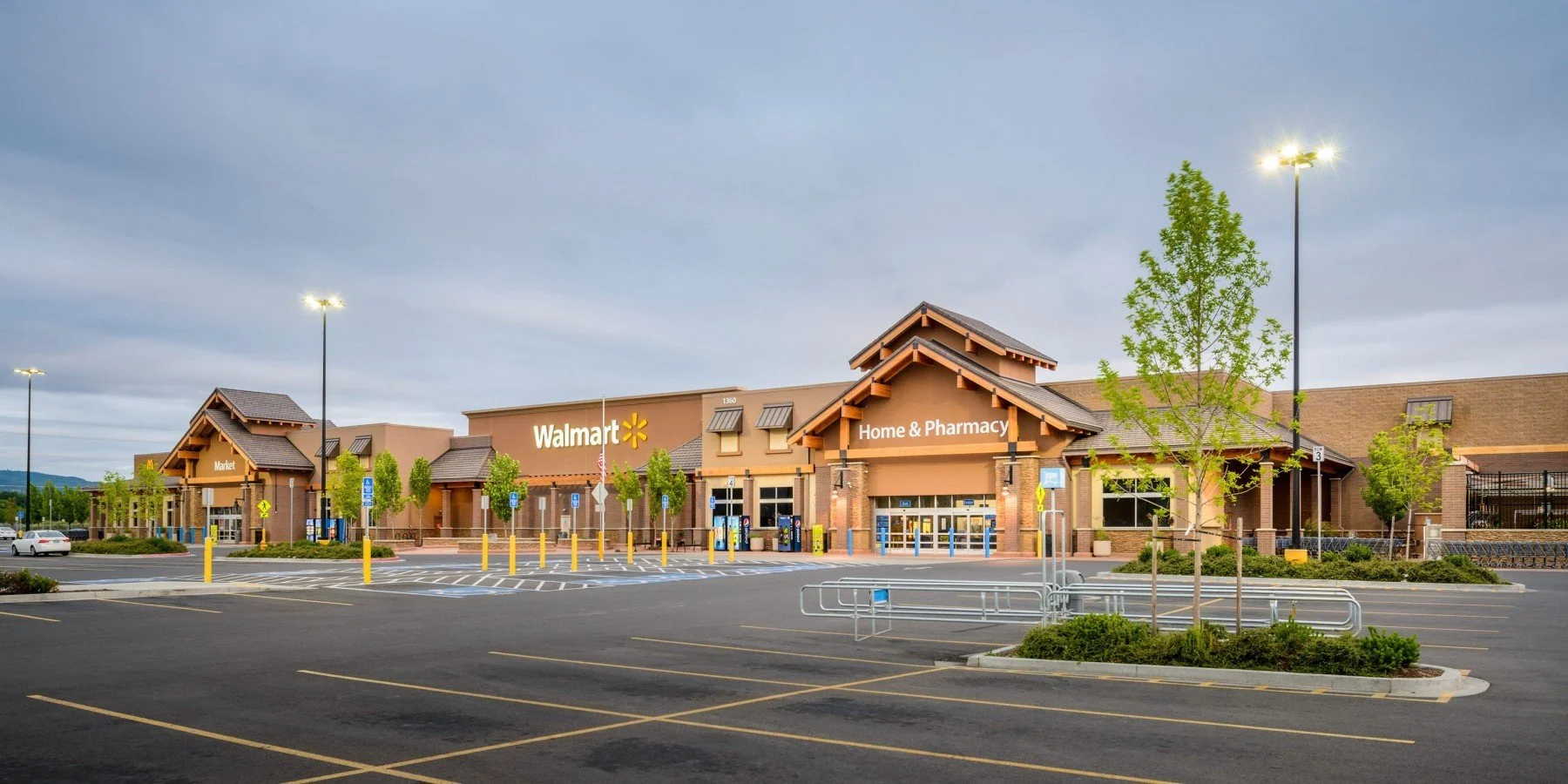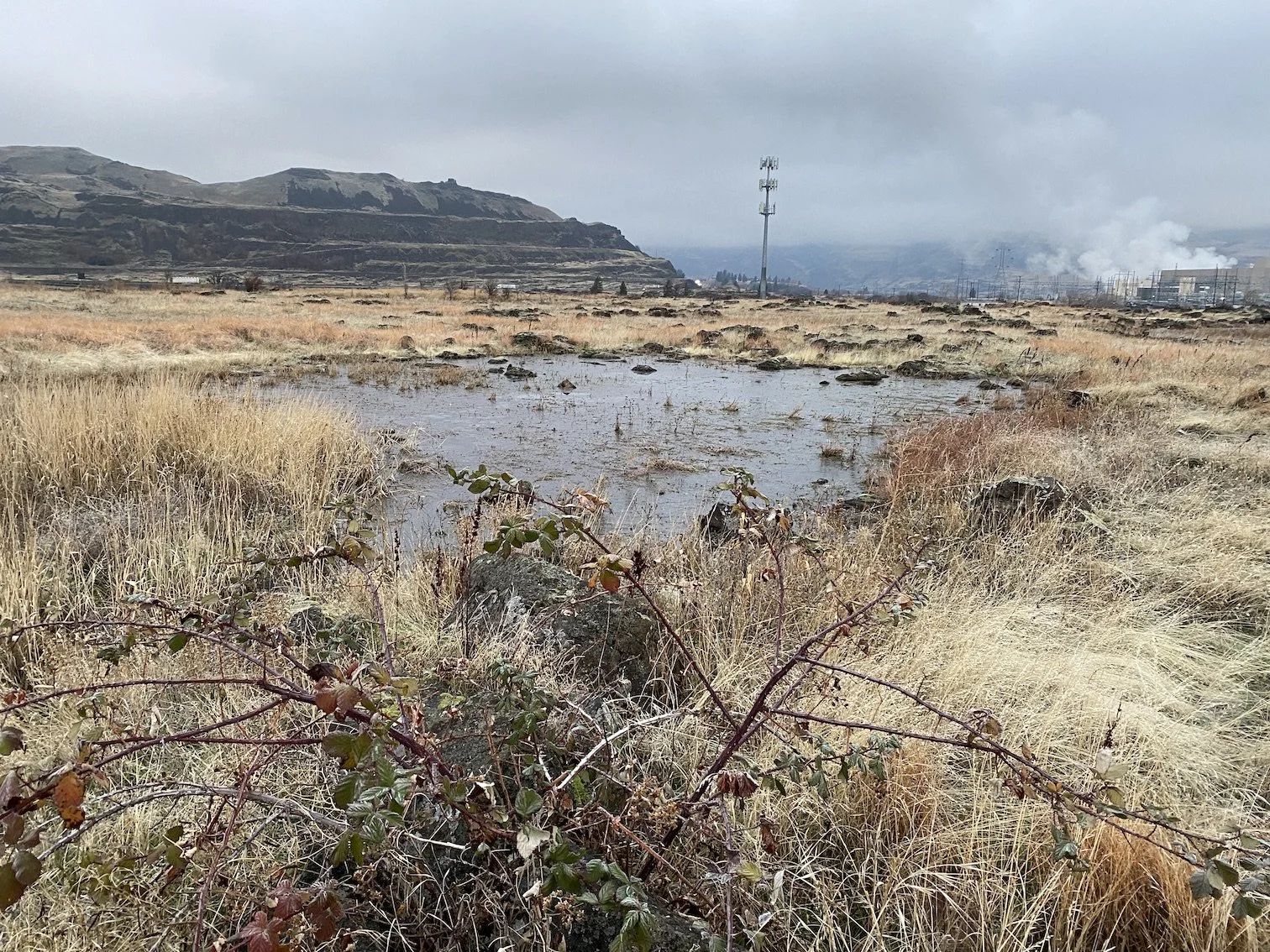Judge finds fish impacts minimal clearing way for Walmart in TD; Legal wrangling, however, not likely over
Here is an example of a Walmart supercenter located in Medford Oregon. This is. the type of store that is being proposed in The Dalles since 2010.
By Tom Peterson
The construction of a Walmart supercenter in The Dalles gained some ground after Administrative Law Judge Jennifer H. Rackstraw determined impacts to endangered fish species and fishing would be “at most, minimal” if the store is built, in part, on seasonal wetlands in West The Dalles.
The Judge’s 133 page order came in late November, and it clears a path for the Division of State Lands to issue a permit to remove and fill wetlands. The lack of a permit has halted the development for years.
Rackstraw and the Oregon Office of Administrative Hearing’s role is to provide an independent and impartial forum for citizens and businesses to dispute state agency action against them. In this case, Walmart disagreed with the Division of State Land’s decision to decline a permit for fill and removal of wetlands during the construction of its supercenter.
Location of property currently leased by Walmart in the Port of The Dalles.
Does Walmart still want to build?
Whether Walmart is continuing to truly pursue the 147,000-square-foot store on River Road in The Port of the Dalles after 12 years of litigation remains unknown to CCCNews.
“We are pleased with the Judge’s decision, and are evaluating the next steps,” said Lauren Willis with Walmart Corporate Affairs in a one-sentence email. She did not respond to questions about moving forward with the construction of the supercenter.
Reaction from Citizens for Responsible Development
Local group, Citizens for Responsible Development in The Dalles has been actively opposing the development in court for a decade.
“It makes me sad,” said John Nelson, spokesperson for the Citizens for Responsible Development. (The permit) “probably will go through in late December or late January, and they will get a final order from Oregon State Lands for that permit.”
Water gathers on a basalt rock on property currently leased by Walmart in the Port of The Dalles.
Nelson said he was unsure if his group would appeal the decision to the Oregon Court of Appeals if the permit is issued.
Karl Anuta, attorney for the Citizens for Responsible Development, said he was still studying the opinion earlier this month .
“How did it magically mushroom into something that outweighed the harms?” he questioned.
“I have not digested all of the details,” he said. “We have 30 days to file acceptions” - items in the Judge’s Order that they believe are inaccurate conclusions either factually or legally.
Will you appeal?
“My suspicion is that we will,” he said.
The site of the proposed store is a 67-acre parcel hemmed in by Interstate 84 and River Road. The site is locally owned. However, Walmart leased the property for 99 years in 2013, a lease that continues to be active. The project involves the construction of a 147,782-square-foot retail store, and approximately 8.2 acres of parking.
Judge Rackstraw’s Order
“I propose that the Department of State Lands issue a Final Order consistent with the following determination:
The project described in Walmart’s permit application “would not unreasonably interfere with the paramount policy of this state to preserve the use of its waters for navigation, fishing and public recreation” pursuant to ORS 196.825(1)(b), based on the weighing process set forth in CFRD v. Walmart, 366 Or 272, 285-86, 290-91 (2020).”
In her examination of the evidence presented, she concluded that the impact was “at most, minimal.”
“…The proposed project is unlikely to jeopardize the continued existence of those species (ESA-listed fish including steelhead and Chinook) or destroy or adversely modify critical habitat designated for them,” she wrote.
Contentious since the Get-Go
The store’s construction has been met with contention since its announcement and subsequent planning approvals from The City of Dalles more than a decade ago.
Some argue it would destroy wetlands, draw customers away from existing businesses and not pay a living wage in The Dalles, being a net loss for the community.
On the other hand, many in The Dalles contend Walmart services are needed and the store's construction would bring large property tax payments and jobs for the community.
A Long Legal Road
In 2013 the Department of State Lands (DSL) issued Walmart a permit to fill and remove wetlands on the proposed 67-acres site for the construction of the superstore. The area has seasonal wetlands where depressions in the land create pools (vernal pools) of water that are used by wildlife and plants.
Citizens for Responsible Development (CFRD) in The Dalles asked for a summary determination in the case and the permit order was upheld.
DSL issued a final order for the permit in 2014, and CFRD appealed the decision to the Oregon Court of Appeals.
In 2018, the Court of Appeals remanded the permit request back to DSL.
DSL sought a review from the Oregon Supreme Court.
In 2020 the Supreme Court affirmed the Appeals Court decision but found an error “to the extent that the appeals court construed a statute to require that every permit for fill or removal must be supported by a finding that ‘public need’ for the project ‘predominates.’
The Supreme court opined that DSL must determine whether the interference with the policy to preserve the use of its waters for navigation, fishing and public recreation is “unreasonable” by weighing the interference against the expanded list of public-benefit considerations that Walmart argues it will bring. And to this, the Court said the record was inconclusive.
“The record is inconclusive with regard to whether the project, for which the fill or removal is proposed, will address a public need, according to Rackstraw’s history of the Supreme Court case.
This set the stage for hearings held last October where Judge Rackstraw listened to testimony for and against Walmart in regard to the public need, specifically, social, economic and other public benefits that would result from the project.
Several witnesses testified before the court including:
On behalf of Walmart, Matt Martinez, owner and Founder of M & M Real Estate Consultants LLC, a real estate broker specializing in site selection for national chain stores and services
On behalf of Citizens for Responsible Development, Luise Langheinrich of The Dalles, a former petroleum geologist with a Master’s in Business Finance and a resume including senior program manager for projects in the aerospace industry.
Public Need Analysis and The Dalles Trade Area
Martinez described The Dalles trade area as Wasco, Sherman, and Gilliam counties, serving the cities of Antelope, Dufur, Maupin, Mosier, Shaniko, Biggs Junction, Wasco, Moro, Erskine, Grass Valley, Condon, Mayville, and Arlington in Oregon. The trade area extends to Washington with The Dalles Bridge and serves the cities of Lyle, Klickitat, Goldendale, Dallesport and Wishram. * * *. Those communities don’t have adequate population to support any more than convenience retail and consumers must travel to The Dalles to meet their larger retail needs. The population of this overall trade area * * * is 40,057, he told the court.
He also pointed out that despite solid population growth for several decades, The Dalles has lost many of its Daily Needs retailers. These include Kmart of 87,100 SF closed in February of 2020; Sav-a-lot of 36,192 SF closed December of 2012; and Albertsons closed its 31,221 SF location in 2010 (Goodwill redeveloped the former Albertsons building in 2013). The only Daily Needs retailer to open that offset those losses was Grocery Outlet. This has left The Dalles consumers with less square footage of daily needs retail offerings, despite having a higher population.
He went further to state, It is an acknowledged principle of supply and demand that when supply decreases, and demand increases, prices increase. It appears that may be the case within The Dalles Trade Area where the Trade Area has lost many of its Daily Needs retailers while at the same time there has been an increase in population. As a result, there is a public need for more retail competition within The Dalles Trade Area to provide competitive pricing for consumers.
Langheinrich with Citizens for Responsible Development poked several holes in Martinez’s argument.
"In my opinion, the proposed Walmart project is not economically beneficial for The Dalles and its surrounding areas," Langheinrich, the president of CFRD testified.
She disagreed with Martinez’s decision to exclude Hood River from The Dalles' trade area which does include Mosier - 15 miles away. She and Nelson both testified that people from The Dalles and Hood River travel back and forth for shopping.
She also pointed out that his inclusion of all populations within his analysis including children was wrong, inflating the market size, and thus exaggerating the need for the superstore. Children are not actual shoppers, she testified.
She said U.S. Census data for the age range of 15 through 84 more accurately reflects the trade area population of actual potential shoppers.
Cannibalism
Langheinrich also said the only way Walmart will be able to draw in the revenue that a supercenter in The Dalles commands is by cannibalizing from existing stores by, for example, undercutting competitors' prices.
She pointed out that Martinez failed to mention the following stores in his analysis of retail offerings in The Dalles for Daily Needs:
Discounts Plus (in former JC Penney spot)
Juanita's Marketa
US Foods Chef's Store (formerly Cash & Carry)
Center Market The Dalles
Allen's Food Center
La Michoacana Store
Center Market 12th Street
Dinty's Market West
Franz Bakery Outlet
Dollar Daze grocery store
AT&T wireless phones & technology
Verizon wireless phones & technology
T-Mobile wireless phones & technology
US Cellular wireless phones & technology
Maurices (chain clothing store)
Blossomly Boutique (women's clothing)
Panaderia La Ideal (Mexican goods)
Lines of Designs women's clothing
Terra Cotta Gorge Co. women's clothing
Willow & Bark women's clothing
Emma's Bowtique children's clothing & goods
Angel's Panaderia bakery
Klindt's Booksellers & Stationers
Petite Provence bakery
Sandoz Farms-farm produce, meats, canned goods
The Dalles Farmers Market seasonal June-October
Evans Fruit Stand-produce market
Ace Hardware
Bohn's Printing & Office supply
She also projected that Walmart would bring low-paying jobs to The Dalles. "Generally speaking, most Walmart retail store associates live within a very concise radius (perhaps two miles) from the Walmart store where they work," she said.
A report by the National Low-Income Housing Coalition in July 2021 showed that an individual working for an hourly wage of $16.40 in Wasco County could not afford to rent a one-bedroom home there.
Wetlands Impact
Walmart described the wetland impact as such in its application to the Oregon Department of State Lands:
“These 2.174 acres wetland impacts would be offset by a combination of onsite mitigation totaling 1.330 acres of wetland creation (new wetland), 0.640-acre of wetland restoration (removal of old fill material in former wetlands), 0.575-acre of wetland enhancement, 2.422 acres of wetland preservation (protection of high value wetlands), and 7.775 acres of upland buffer (that serve to recharge the wetlands)[.]
Wetland such as this pool in West The Dalles would be filled and or removed if the construction goes ahead.
Biological Opinion
The National Marine Fisheries Services' biological opinion states the development would have an adverse affect on fish: “The proposed action will affect all eight ESA-listed species and their designated critical habitat in this opinion. The proposed action will affect the critical habitat by causing physical and chemical changes. As a result of long-term water quality degradation through input of sediment and chemical contamination in stormwater, the proposed action will have direct effects to juvenile and adult ESA-listed steelhead rearing, migration and spawning in Chenoweth Creek, as well as to all salmonids in the Columbia River portion of the action area.”
It notes that runoff into the creek and Columbia River will change from a natural watershed to roof and parking lot runoff.
Wetlands Demise?
David Gorman on behalf of Citizens for Responsible development testified that the discharge of urban stormwater to those preserved and created vernal pool wetlands will ultimately lead to their demise. The project’s proposed design, operation, and mitigation will ultimately negatively impact all of the functions and values of the vernal pool and swale wetlands. Loss of these functions and values will result both directly and indirectly in the loss of fishing and other recreational activities for the public.
Civil Engineer Scott Franklin on behalf of Walmart refuted those claims in a letter to the court. He asserted Gorman’s arguments regarding the Storm Water Management Plan were already raised and addressed, either through initial consultation with the Department, DEQ, USACE, and/or NMFS, or through various appeals. Mr. Franklin further states that all such issues were addressed to the satisfaction of those agencies and each agency issued the required approvals, subject to conditions requiring mitigation. Mr. Franklin asserts that Mr. Gorman offered flawed and erroneous opinions, oversimplified the stormwater analysis, and ignored “the specific design elements of the proposed storm system.”
Public Benefits
According to Walmart, the proposed project would inject over $15 million into the Wasco County economy for planning, surveying, infrastructure and building construction and related site improvements. It would also provide over $4 million for offsite public improvements/infrastructure. Long-term economic benefits to the local economy include over $4.5 million annually from employee incomes. The project would also generate over $150,000 in new real estate taxes (currently $30,000 per annual for vacant land). Lastly, system development charges (SDC) would total $945,000.
Decision and Order
“The evidence demonstrates that the proposed project will likely cause a minimal degree of interference with fishing and public recreation,” Rackstraw wrote. “Although the record does not establish a public need (as the Department has historically construed the term) for the proposed Walmart Supercenter, the record supports a finding that there will be public benefits resulting from the proposed store in the form of increased employment opportunities (150 temporary jobs and 350 permanent jobs) and economic benefits to the public (public infrastructure improvements, tax revenues, and system development charges and fees). The record also shows that there is likely to be at least a minimal economic cost to the public if the proposed project is not completed.
“It is difficult to assign value to such disparate things as the project’s potential interference with the public’s right to fish and recreate (based on the effects of a project that will cause some degree of wetland destruction and degradation, stream and river pollution, fish mortality, and wildlife mortality and displacement) and the project’s benefits to the public (based on increased employment opportunities and economic benefits).
Fortunately, the weighing process herein does not require such a valuation. Instead, this case is decided on the weight of the evidence.
On the one side, the evidence establishes that the proposed project will have at most a minimal interference with fishing and public recreation at Chenoweth Creek and the Columbia River. On the other side, the evidence shows the proposed project provides at least moderate social, economic, and other public benefits to The Dalles community and at least minimal economic cost if the proposed store is not built.
The evidence of interference with use of waters of the state does not outweigh the evidence on the public benefit side of the equation. The greater weight of evidence is on the side of public benefits and economic costs without the project.
Walmart has therefore satisfied its burden of establishing that the proposed project will not unreasonably interfere with the paramount policy of the state to preserve the use of its waters for navigation, fishing and public recreation, based on the weighing process set forth in Citizens for Responsible Dev. in The Dalles v. Wal-Mart Stores, Inc.”
What Happens Next
It remains to be seen whether plans for the Walmart supercenter in The Dalles even fit with the company's current business model as they have been locked in a fight for market share with online retail giant Amazon.
Support Local News
Available to everyone; Funded by readers.
Nelson said if the permit is issued for the current plans, but the company decides to make any changes, they would have to start the permitting process all over again.
A June news release from Walmart might give some hints on their current direction:
“While there are countless ways we strive to earn customers’ trust, delivering on our promise of fast shipping and delivery has never been more important to us. Today we use our 31 dedicated eCommerce fulfillment centers and 4,700 stores located within 10 miles of 90% of the U.S. population to fulfill online orders at exceptional speed. But we’re not stopping there. We know we must constantly exceed our customers’ expectations, which is why I’m thrilled to announce we’re building four next generation fulfillment centers (FCs) over the next three years, with the first opening this summer in Joliet, Illinois. These FCs will be the first of their kind for Walmart, using the powerful combination of people, robotics, and machine learning to set an entirely new precedent for us on the speed of fulfillment while continuing to create a positive work environment for our associates.”





